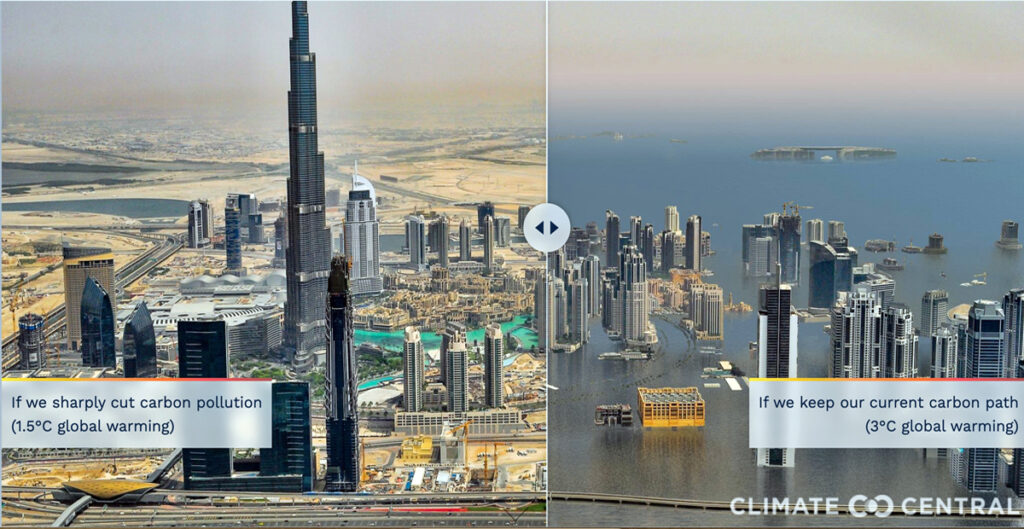Dear Friends,
Climate hope and concern swung back and forth like a metronome this year, with countervailing narratives filling our inboxes and airways. Was it a good year or a bad one in the world of climate?
Without “copping out” – a groan-worthy pun after returning from COP28 – we’d have to say both.
Exacerbated by a strong El Niño, the average global temperature rise in 2023 was projected to reach 1.4°C, perilously close to the 1.5°C ceiling scientists say we need to stay below to safely deal with the ensuing climate impacts. And as our temperatures rose, our emissions did too: we posted the worst emissions year ever, a grim testament to our dependence on fossil fuels to run our economies. Scientists fear we are locking in tipping points – systemic changes to our natural world that will lead to severe economic and environmental disruption – that humans will not be able to stop or reverse.
Yet plenty went well in 2023. Clean-tech innovation continued at a frantic pace. Renewables expanded rapidly, proving to be both more affordable (cheaper and not tied to volatile world markets) and, in many cases, more reliable than fossil fuels (which tend to fail at extreme temperatures and with extreme drought). We also saw a glimpse of the future, with Europe and the UK sealing deals to import solar and wind energy from northern Africa via undersea cables rather than import natural gas from Russia through pipelines. And in the United States, wind, solar, and battery storage facilities are opening at astonishing rates, an average of one every four days, and next year wind and solar will provide more electricity here than the former “king of energy” (coal).
The COP28 global climate summit also provided hope, as the world community for the first time acknowledged fossil fuel use is causing the climate emergency and called for a “just transition” away from them. Fifty oil companies responsible for nearly half of global oil output pledged to deeply cut methane emissions by 2030, a decrease that could have real and almost immediate benefits. We saw clear wins in the focus on nature as a tool to fight climate changes, the importance of protecting and innovating our food and health systems, and the financing of the loss and damage fund to help poorer countries adapt.
And crucially, the business and financial community was heavily represented at the summit, a clear indication that the energy transition now represents great opportunity instead of economic sacrifice, and that entrepreneurs, investors, financiers, and corporations are all vying to capitalize on clean tech’s explosive growth and potential.
So we end the year clear-eyed about the dangers but hopeful about humanity’s ability to pivot and innovate. If we act decisively, we will be able to plan for and handle the changes we have set into motion. But each of us is called to action: how we buy, invest, work, drive, build, and vote matters. Every business, community, financial, and political leader should feel the pressure to bring solutions forward. And that pressure has to come from us. Raising our voices loudly and often could be our most important New Year’s resolution ever.
Sincerely,
The C-Change Conversations Team
Notable Quote
“Present trends are racing our planet down a dead-end, 3-degree temperature rise. …The emissions gap is more like an emissions canyon. A canyon littered with broken promises, broken lives, and broken records. … All of this is a failure of leadership, a betrayal of the vulnerable, and a massive missed opportunity. Renewables have never been cheaper or more accessible.”
– U.N. Secretary-General António Guterres at the onset of COP28
News of Hope
While COP28 did not succeed in setting us on a path to keep temperature rise below 2°C, it did mark an important evolution in world opinion, which can change the trajectory of climate action going forward. Though many lament the phrase “transitioning away” from fossil fuels as insufficient, the fact is, those words do matter. People may say that the pledges made at COP aren’t binding, but nor were they in the Paris Agreement, and look where we are now – renewables are eating fossil fuels for lunch, because they’ve become so cheap and can be so much more reliable than their carbon-producing predecessors. Once-esoteric ideas like EVs are a reality growing so fast that some countries are on track to stop selling combustion engine cars completely in the 2030s.
Words matter, actions matter, especially at the polls. This tidbit blew our socks off: older voters are second only to the youngest ones in prioritizing the climate at the polls – and their votes may be enough to swing key states. Pollsters are telling politicians to sit up and take note – and perhaps they are. Republicans from conservative climate caucuses were at the COP discussions in force, and it will be telling to see how this plays out during our impending national elections. On the state level, bipartisan climate action is moving steadily forward as 25 governors committed to serious pollution reduction efforts to hit 2025 goals. This type of commitment matters, especially from the larger states. California, for instance, is so big, it’s almost a nation itself, and the economic and climate policies it adopts carry over into other states as manufacturers design their production lines to comply with those regulations.
Clean tech continues to drive U.S. economic growth in places like the Southeast and Midwest, where “climate action” may not steer politics so much as the simple math of the tax base. There are jobs, jobs, jobs in renewable energy – the fastest growing job in the U.S. right now is wind turbine technician – and they are ample, well-paying, and there are options for almost every level of education. And there’s every reason to believe we’ll keep the wind in our sails as construction begins on the largest clean-energy project in U.S. history. It’s a project at a scale that we’ve historically only seen with fossil fuels and it shows just how big of a player renewables now are in creating safe, reliable energy.
The sensibility of such investments was demonstrated in Europe in recent months. Portugal wins the grand prize for creating enough renewable energy to run the country of 10 million people entirely on wind, solar, and hydropower for six days in a row. Not only did Portugal keep its own lights on without any backup from fossil fuel power, it exported spare clean electricity to Spain during this stint. And in December, British wind farms set a clean-energy record by creating more than half of the UK’s electricity during a major storm.
And it’s not just wind, solar, and hydro that will propel us toward climate stability. Other clean-tech innovations are also improving. Take the sodium-ion batteries that a Swedish startup says use no lithium, cobalt, or nickel, eliminating the need to mine precious metals and lessening dependence on China. Developments like that hold tremendous promise both for the climate and for geopolitical stability. And advancements like the first long-haul flight fully powered by sustainable aviation fuel (made from waste fats and plant sugars!) could change the carbon footprint of our human wanderlust.
We also have more ways to measure that footprint and hold countries, businesses – ourselves – accountable. From high-tech satellites to a new database system backed by Former Vice President Al Gore that tracks nearly every source of greenhouse gas around the world, new tools that measure the transparency of emissions make it harder for entities to continue to support polluting practices – and easier to decarbonize their supply chains.
Notable Graph

Climate change is causing sea levels to rise, but it’s hard to envision what that will actually look like across the world. With this projection tool from Climate Central, we can see just how devastating a difference of 1.5 degrees Celsius might make in the future.



